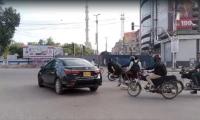The outbreak of the novel coronavirus has petrified the entire world. The viral disease has been a menace for the people of both genders and all ages.
Most vulnerable
According to medical experts, people over the age of 55 years are more vulnerable to the disease than the younger lot. Those battling cancer or cardiac diseases are also vulnerable to COVID-19. Patients of other diseases that affect the body’s immune system may also find it hard to combat the virus.
Dr Mahim Akbar, a Pakistani doctor settled in New York, says that all the patients of COVID-19 who came to her had someone from their families or friend circles falling prey to the viral disease, and a significant number of such people were diabetics.
She says that people in their 20s, 30s or 40s have also been contracting the coronavirus; however, it is the elderly who are more prone to the complications of the disease. If the oxygen level of the elderly COVID-19 patients is not satisfactory, medical experts have to immediately decide if they need to be put on ventilator, she explains. She also says that many of those who have a weak immune system are unable to recover from this stage. In some cases of extreme complications, patients of COVID-19 may suffer a heart attack, she adds.
More male victims
There are more men than women who have succumbed to the novel coronavirus, not only in the US but also across the world. However, the World Health Organisation says that people of all ages and genders should equally take precautionary measures against the disease.
Strategy against COVID-19
To prevent the contagious disease from spreading, countries around the globe adopted the policy of enforcing social distancing through lockdowns to flatten the curve of the number of COVID-19 patients against time.
Dr Michael Merson, a health expert from the Duke University in the US, says it is too early to say if the strategy of flattening the curve is sustainable in the long run or what could be the next plan of action if the virus strikes again. He is of the view that all the countries should closely monitor the situation in China’s Wuhan city to check how things have been unfolding there after the resumption of social activities.
Successful countries
Among the countries that have combatted the pandemic effectively is China, which ensured that people in Wuhan and other places affected by the contagious disease were tested for it and that the suspected patients were quarantined at the government-run centres.
China trained doctors, lab workers and paramedical staff from all over the country and sent them to Wuhan, who ensured that the entire population of the city was tested.
The Chinese authorities also made it sure that families of the affected areas received food items at their homes, due to which the people accepted the lockdown.
South Korea, Germany and other countries that succeeded in limiting the number of coronavirus-related deaths had also started to carry out tests, trace the contacts of confirmed and suspected patients, and monitor the patients through a mobile app in the early stages.
South Korea, Singapore, Hong Kong and Japan used lessons of their past experiences to deal with the COVID-19 pandemic. Singapore and Hong Kong were among the worst-affected countries due to the SARS epidemic in 2003, whereas life in South Korea had come to a standstill due to the spread of MERS in 2015.
Mistakes by US, Italy
There was a difference of only one day when initial cases of the coronavirus emerged in the US and South Korea. In the US, however, the cases eventually rose to hundreds of thousands, while the timely action in South Korea succeeded in bringing down the number of new cases from 900 a day to just 100.
The reason why South Korea managed to flatten the curve was that it took action in the early stage and carried out tests on a massive scale.
South Korea also managed to effectively trace the suspects. The government ensured that all the passengers landing on the Seoul airport were screened for fever. The passengers were then told to download the self-diagnosis app of the South Korean health ministry. After reaching their destinations, the passengers were supposed to use that app on a daily basis and immediately report to the authorities in case they developed any symptoms of COVID-19.
Those who tested positive for the disease would be continuously monitored and people living nearby would be sent alert messages on their mobile phones so they did not establish physical contact with the patients.
South Korean authorities also introduced drive-through testing services to make it easy for the people to undergo the COVID-19 test. Korean kits that detect virus in 10 minutes were later imported by the US.
The Eid milan party was organised by the students of Aiwan-e-Quran of AIMS Education System, here. The students and...
Jacaranda Family Club, DHA-2 Islamabad. — x/islaamabadIslamabad: Innovista Rawal, a dynamic co-working space,...
The 22nd convocation of Islamabad Model College for Girls Postgraduate, G10/4 was held at the college auditorium on...
Dean of Indus University, Dr Aftab Madni. — Indus University websiteIslamabad: Dean of Indus University, Dr Aftab...
Poets from Pakistan, Canada and the US reading out their poems in Mushaira held at the launch of the PST Canada...
Relatives sit next to patients suffering from dengue fever resting under a mosquito net at a hospital in Pakistan. —...







